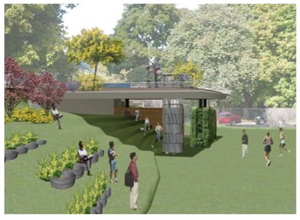Greening School Facilities
Our students learn what they live. If they spend all their school days in sterile classrooms, prison-like buildings and lifeless playgrounds, they will not become creative and critical thinkers, and they will not learn that human beings are a part of the beautiful web of life. Why should schools, by their very design, be allowed to kill the wonderful spirit of our youngest citizens?

In nature a repulsive caterpillar turns into a lovely butterfly. But with human beings it is the other way round: a lovely butterfly turns into a repulsive caterpillar.
— Anton Chekhov, Russian writer (1860-1904)
Greening school facilities means designing (and then building or renovating/retrofitting and decorating) school environments that help students stay connected with the rest of Nature, while also helping them learn, both passively and actively, about energy efficiency and green building design.
Greening School Facilities — Design, Renovation/Building, Decor
While I was working as the Coordinator of Environment and Sustainability Programs at an independent boys' school in Toronto, a school goal was to renovate all the classrooms at the secondary school (grades 8 to 12) within the next few years. Because this was a Green School, a committee was struck to ensure that the renovations would be as environmentally friendly (and student/teacher/learning friendly) as possible. With many thanks to the OLE (Optimal Learning Environments) Committee members, I would like to share our final template with you, because
- some of these ideas can be implemented even if you're not renovating, without much cost, and
- several of the ideas could contribute to your transformative sustainability education efforts.
The goal was to use research-based best practices, state-of-the-art technology, and sound design principles to intentionally create (by building or renovating) classrooms that are healthy, environmentally friendly, and conducive to effective learning and teaching.
The purpose of this template was to share with architects, designers and others the criteria we believed would best support students and teachers in their education programs, within our Green School framework.
Three caveats:
- The criteria listed here are interactive and interconnected. Some synergistic effects or unintended consequences are possible.
- Trade-offs might be necessary to contain costs. Through reflection and discussion, we identified those features we deemed "Baseline" (must be included) and those we deemed "Ideal" (would be great to include, if feasible).
- We kept three main objectives in mind while researching and selecting these criteria:
- First, the students and their learning are to be foremost in deliberations and decisions at all times.
- Second, these renovations should meet the needs of students for the next 40 to 50 years (plan for longevity, not obsolescence).
- Third, the aim is to create learning environments that will contribute to the mission of the school while helping teachers and students attain Green School goals.
Greening School Facilities and Operations
Design Criteria Template
- Safety, Comfort and Aesthetic Elements
- Developmentally Appropriate and Student-Centred Learning Features
- Flexibility
- Furnishings
- Instructional Technology
- Sensory Perceptions: Sound, Light and Colour
- Ecofriendly Features: Lighting, Ventilation and Climate
- Integration and Connection (my personal favourite!)
- Good for Teachers and Their Teaching
I acknowledge that not all the criteria listed on these pages will be suitable for all cultures and climates, but the more humane our schools, classrooms and playgrounds, the more humane our students will be toward each other and the rest of Nature.

Ideas for Greening School Facilities and Operations
I recently asked a group of students and parents in a smaller community what environmentally features they would like to see in their school. For each suggestion, see if you can picture the curriculum integration and the behaviour changes that would naturally follow. Here's what they had to say:
- build a school garden to help students reconnect with the natural world, learn how life works, and pick up valuable food-production skills
- install a greenhouse, to extend the school's growing season
- reclaim and retree portions of the field that aren't used for sports (perhaps with permaculture by planting fruit trees and bushes, and certainly using native species)
- build an outdoor classroom so that classes can spend formal learning time outdoors
- install a living wall to bring Nature indoors
- install a rainwater collection system, to help students learn the value of water conservation (and especially if your school has a garden)
- ensure that all toilets are low flow, and that urinals don't run all day (or install waterless urinals); strive for a greywater system for flushing
- install energy-efficient heating and lighting systems to complement energy conservation measures
- install motion detectors in classrooms and hallways to make the lights go out when there's nobody there
- install solar panels and a wind turbine (these needn't be full-scale — more like demonstration projects for the students — although what a great example your school would set for the community if it managed to become energy self-sufficient; the point is to start familiarizing our students with the renewable energy technologies that could help ensure them a future)
- build and place pedal-powered recharging stations throughout the school
 Artist's rendition of an outdoor classroom
Artist's rendition of an outdoor classroom
By the way, if you'd like a simple way to start greening your school facilities, put plants in the classrooms, hallways and offices. And bring flowers! Researchers at Rutgers University explored the link between flowers and life satisfaction, and discovered that flowers immediately impact happiness. All participants in the study demonstrated extraordinary delight upon receiving flowers — a universal reaction that occurred in all age groups. Participants also reported feeling less depressed and agitated, and showed a higher sense of enjoyment and life satisfaction after receiving flowers. Plus, the presence of flowers led to more intimate connections with family and friends.
You don't need a task force or a study group to buy flowers for your kids. What you need to know is that the children and the adults [in your school] deserve flowers in their life. The cost is incidental, but the gesture is huge.
— Bill Strickland

I should mention that these suggestions above came from a school that already composts lunch waste and has a full recycling program in place, which is taken care of by the middle school students in partnership with the community's recycling depot. The 3Rs — Reduce, Reuse, Recycle — come first.
If you want to learn more about greening school facilities, a good starting place is LEED for Schools (LEED is the Leadership in Energy and Environmental Design Green Building Rating System™), or the U.S. Green Building Council's Center for Green Schools.
Here's to schools becoming as safe, healthy and inviting as we'd like our students' homes to be. Indeed, here's to schools becoming homes away from home!
Do You Have a Story to Share
About Greening School Facilities?
Do you have a great story about greening your school's facilities? If you'd like to contribute an idea or a project that your school is working on, please let us know about it. We'd love to hear from you!
Stories of Greening School Facilities
Shared by Others
Click on the links below to read the stories contributed by other visitors to this page....
Schools making gardening accessible to all of their students
Our company is Accessible Gardens. We have been providing handicap/wheelchair-accessible raised gardens for about 10 years. We have been primarily targeting …
Fertilizer
How about some information on plant nutrition? The world is actually depleting the sources of chemical fertilizer. Nitrogen in commercial fertilizer comes …
MY GREEN SCHOOL!
Our school has a system where if a child is interested, he or she can present a tree to the school that will be planted in a separate garden and will be …

Return from Greening School Facilities to School Greening
